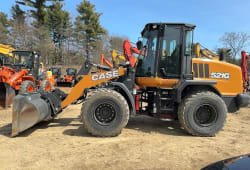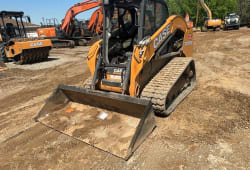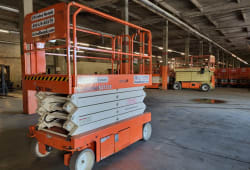Why Drivetrain Inspections are Crucial for Heavy Equipment Longevity
11 Lectura mínima
)
noviembre 17, 2023
Mario Ramirez, an expert heavy equipment inspector at Boom & Bucket, shares his deep expertise in heavy equipment inspection so you can make better buying decisions.
When it comes to heavy equipment, one crucial aspect that often gets overlooked is the drivetrain. The drivetrain plays a vital role in the overall performance and longevity of the equipment. Understanding its components and how it contributes to equipment function is essential for proper maintenance and care.
Understanding the Role of Drivetrains in Heavy Equipment
Before delving into the importance of drivetrain inspections, it is crucial to grasp the basic components of a drivetrain. A typical heavy equipment drivetrain consists of various parts working together seamlessly to ensure smooth operation. These include the transmission, transfer case, driveshaft, differentials, and axle shafts.
By distributing power from the engine to the wheels, the drivetrain enables the equipment to move and carry out its tasks effectively. Furthermore, the drivetrain plays a significant role in determining the performance capabilities, such as the equipment's towing capacity, torque, and speed.
The Basic Components of a Drivetrain
Let's take a closer look at the basic components of a drivetrain:
Transmission: This component transfers power from the engine to the driveshaft.
Transfer Case: Found in all-wheel drive and 4-wheel drive vehicles, the transfer case splits power between the front and rear axles.
Driveshaft: The driveshaft connects the transmission to the differential, allowing the rotation of power from the engine to the wheels.
Differentials: Differentials distribute power between the wheels, allowing them to rotate at different speeds during turns.
Axle Shafts: Axle shafts transmit power from the differentials to the wheels, enabling the equipment to move forward or backward.
How Drivetrains Contribute to Equipment Performance
The drivetrain's impact on equipment performance cannot be overstated. A well-maintained drivetrain ensures smooth operation, optimal power distribution, and seamless movement. Proper power distribution is crucial for heavy equipment to handle heavy loads efficiently, especially in demanding worksites.
Besides power distribution, drivetrains also affect the equipment's speed and maneuverability. A healthy drivetrain allows the equipment to reach its intended speed levels smoothly and maintain stability during turns. It plays a crucial role in ensuring overall efficiency and productivity.
Additionally, drivetrains are designed to withstand the extreme conditions often encountered in heavy equipment operations. They are built to handle high torque loads and provide the necessary strength and durability to support the equipment's demanding tasks.
Regular drivetrain inspections and maintenance are essential to keep the equipment operating at its peak performance. This includes checking for any signs of wear and tear, lubricating the components, and replacing any damaged parts. By staying on top of drivetrain maintenance, operators can prevent costly breakdowns and ensure the longevity of their equipment.
Furthermore, advancements in drivetrain technology have led to the development of more efficient and environmentally friendly heavy equipment. Manufacturers are constantly working on improving drivetrain systems to reduce emissions, increase fuel efficiency, and enhance overall performance. This not only benefits the operators but also contributes to a cleaner and more sustainable environment.
In conclusion, drivetrains are the backbone of heavy equipment, enabling them to perform their tasks efficiently and effectively. Understanding the role and components of a drivetrain is crucial for operators and maintenance personnel to ensure proper maintenance and maximize equipment performance. By investing in regular inspections and maintenance, operators can prolong the lifespan of their equipment and optimize its capabilities.
The Importance of Regular Drivetrain Inspections
To maintain the optimal function of heavy equipment and prolong its longevity, regular drivetrain inspections are essential. Regular inspections allow for the early identification of potential issues and the prevention of unnecessary wear and tear.
Identifying Potential Issues Early
During a drivetrain inspection, specialists will thoroughly examine each drivetrain component for any signs of damage, wear, or fluid leaks. Early detection of issues such as worn-out bearings, damaged seals, or misaligned components can help prevent more significant problems down the line. By addressing these issues promptly, you can avoid expensive repairs and equipment downtime.
For example, during a routine inspection, a technician may notice a slight vibration in the drivetrain. This could indicate a misalignment of the gears, which, if left unaddressed, could lead to excessive wear and potential failure of the drivetrain. By identifying and correcting the misalignment early on, the technician can prevent further damage and ensure the smooth operation of the equipment.
In addition to identifying mechanical issues, drivetrain inspections also involve checking fluid levels and quality. Low or contaminated fluids can cause increased friction and heat, leading to accelerated wear on components. By regularly monitoring and maintaining proper fluid levels, you can extend the lifespan of the drivetrain and improve overall equipment performance.
Preventing Unnecessary Wear and Tear
Heavy equipment is subjected to harsh working conditions that can result in wear and tear on drivetrain components. Regular drivetrain inspections allow for the identification of parts that are nearing the end of their lifespan. By replacing worn-out components before they fail, you can prevent further damage to the drivetrain and other interconnected systems.
For instance, during an inspection, a technician may discover that the gears in the drivetrain have become worn and are showing signs of pitting. If left unattended, these worn gears can lead to increased friction, decreased efficiency, and even complete failure of the drivetrain. By replacing the worn gears in a timely manner, you can avoid costly repairs and ensure the continued operation of the equipment.
Furthermore, regular inspections also involve lubricating the drivetrain components. Proper lubrication reduces friction and heat, minimizing wear on moving parts. By applying the appropriate lubricants at recommended intervals, you can significantly extend the lifespan of the drivetrain and reduce the risk of unexpected breakdowns.
In conclusion, regular drivetrain inspections are crucial for maintaining heavy equipment's optimal function and longevity. They allow for the early identification of potential issues, such as misalignments and worn-out components, and help prevent unnecessary wear and tear. By investing in regular inspections and addressing any problems promptly, you can avoid costly repairs, minimize equipment downtime, and ensure the smooth operation of your heavy equipment.
The Impact of Drivetrain Failures on Equipment Longevity
The consequences of neglecting drivetrain maintenance can be significant. Drivetrain failures can lead to severe equipment downtime, costly repairs, and even compromised safety for the operators and surrounding personnel.
When a drivetrain fails, it can bring operations to a grinding halt. Imagine a construction site where a crane's drivetrain suddenly fails. The crane is unable to move, causing delays in the project timeline. This not only leads to increased costs but also affects the overall efficiency of the construction site.
Furthermore, the financial implications of drivetrain failures can be substantial. Repairing or replacing drivetrain components can be a costly endeavor. In addition, the downtime resulting from a drivetrain failure can lead to lost revenue and missed business opportunities.
The Cost of Neglecting Drivetrain Maintenance
Failing to perform regular drivetrain inspections and maintenance often results in escalated repair costs. Addressing small drivetrain issues early on is generally less expensive compared to having to replace entire components or the entire drivetrain system. By investing in regular inspections, you can potentially save money in the long run and avoid unexpected breakdowns.
Consider a scenario where a fleet of delivery trucks neglects drivetrain maintenance. Over time, the drivetrains become increasingly worn out and prone to failure. As a result, the trucks experience frequent breakdowns, leading to higher repair costs and extended periods of downtime. This not only affects the company's bottom line but also damages its reputation for timely deliveries.
Regular drivetrain maintenance not only helps prevent costly repairs but also ensures that the equipment operates at its optimal performance level. By addressing minor drivetrain issues promptly, you can extend the lifespan of the equipment and maximize its productivity.
How Drivetrain Failures Affect Overall Equipment Function
Drivetrain failures can have a domino effect on the overall function of heavy equipment. A malfunctioning drivetrain can lead to decreased power delivery, reduced towing capacity, and compromised speed control. This not only affects productivity but also puts additional strain on other parts of the equipment, potentially causing damage to other critical systems.
For example, in the case of a bulldozer with a faulty drivetrain, the decreased power delivery can hinder its ability to push heavy loads. This not only slows down construction projects but also increases the risk of accidents and injuries. The compromised speed control can make it challenging for operators to maneuver the equipment safely, further jeopardizing the well-being of both the operators and those working nearby.
Moreover, when a drivetrain fails, the strain on other parts of the equipment increases. This can lead to premature wear and tear on other critical components, such as the engine or transmission. The resulting damage can be extensive and require costly repairs or replacements.
By ensuring proper drivetrain maintenance, you can mitigate the risk of drivetrain failures and their subsequent impact on overall equipment function. Regular inspections and timely repairs can help maintain the equipment's performance, prolong its lifespan, and ensure the safety of operators and personnel in the vicinity.
Best Practices for Drivetrain Maintenance
Implementing proper drivetrain maintenance practices is essential for preserving equipment longevity and performance. By following these practices, you can ensure that your heavy equipment operates smoothly and efficiently, minimizing downtime and costly repairs.
One of the key practices to follow is scheduling regular inspections. Establishing a routine inspection schedule is the foundation of a proactive maintenance approach. Adhering to manufacturer recommendations or consulting with drivetrain specialists can help determine the appropriate inspection intervals for your specific heavy equipment. Regular inspections will ensure potential issues are detected and addressed promptly, preventing them from escalating into major problems.
During a drivetrain inspection, it is crucial to pay attention to various factors. One important aspect to check for is leaks. Leaks can indicate a problem with seals, gaskets, or other components, and if left unaddressed, they can lead to fluid loss and damage to the drivetrain. By identifying and fixing leaks early on, you can prevent further damage and maintain the integrity of your equipment.
In addition to checking for leaks, inspecting the condition of belts and hoses is also essential. Over time, belts can become worn or damaged, leading to decreased performance or even failure. Similarly, hoses can develop cracks or leaks, compromising the efficiency and reliability of the drivetrain. By regularly inspecting belts and hoses, you can identify any signs of wear or damage and replace them before they cause significant issues.
Examining the drivetrain components for signs of wear or damage is another critical step during an inspection. Components such as gears, bearings, and shafts can experience wear over time due to the high stresses and forces they endure. By closely inspecting these components, you can identify any signs of wear, such as pitting, scoring, or excessive play, and take appropriate action, such as lubrication or replacement, to prevent further damage.
Ensuring proper lubrication levels is also vital for drivetrain maintenance. Adequate lubrication reduces friction and wear, prolonging the lifespan of the drivetrain components. During an inspection, it is important to check the lubrication levels and ensure that the appropriate lubricants are being used. Regularly monitoring and maintaining proper lubrication will help optimize the performance and longevity of your drivetrain.
Additionally, observe any unusual noises or vibrations during operation, as these may indicate underlying drivetrain issues. Unusual noises, such as grinding, squealing, or knocking, can be a sign of worn or damaged components. Vibrations, especially if they are excessive or inconsistent, may also indicate a problem. By paying attention to these warning signs, you can address any potential drivetrain issues before they escalate and cause significant damage.
In conclusion, implementing best practices for drivetrain maintenance is crucial for ensuring the longevity and performance of your heavy equipment. By scheduling regular inspections and knowing what to look for during those inspections, you can detect and address potential issues promptly, minimizing downtime and costly repairs. By following these practices, you can optimize the efficiency and reliability of your drivetrain, ultimately maximizing the productivity of your operations.
The Long-Term Benefits of Drivetrain Maintenance
Investing time, effort, and resources into drivetrain maintenance offers numerous long-term benefits for heavy equipment owners and operators.
Extending the Lifespan of Your Heavy Equipment
A well-maintained drivetrain translates to extended equipment lifespan. By regularly inspecting and addressing drivetrain issues promptly, heavy equipment owners can avoid premature wear and tear, keeping their machinery operational for more extended periods. This reduces the need for frequent equipment replacements, which can be costly and impact overall business operations.
Ensuring Optimal Performance and Efficiency
A properly maintained drivetrain contributes to optimal equipment performance and improved productivity. With efficient power distribution and smooth operation, heavy equipment can perform tasks more effectively, reducing downtime and maximizing productivity. Additionally, equipment that runs efficiently consumes less fuel, leading to cost savings and reduced environmental impact.
In conclusion, drivetrain inspections are crucial for ensuring the longevity and performance of heavy equipment. By understanding the role of drivetrains, performing regular inspections, and addressing any issues promptly, heavy equipment owners and operators can avoid costly repairs, prevent unnecessary wear and tear, and optimize equipment function. Investing in drivetrain maintenance is an investment in the long-term success of your heavy equipment and business.

Caleb Woods is an experienced content specialist and an editor at Boom & Bucket, blending his journalism background with expertise in the heavy equipment industry. He delivers engaging, informative content to help professionals stay informed and make smarter decisions in the machinery market.











